|
Biographical
Notes (by Dionigi Roggero)
Angelo Morbelli was born in Alessandria on July 18th, 1853,
during one of the frequent transfers of his father Giovanni,
born in Casale, employed as deputy minister at the superintendence
of Casale. Angelo’s mother, “Giovannina”
Ferraris, soon died in 1858 and left two children –
Angelo and Alfredo, who completed their studies as boarders
at the Somaschi Fathers priests of Casale Monferrato, where,
as a matter of fact, the Morbelli Family had several estates.
.jpg)
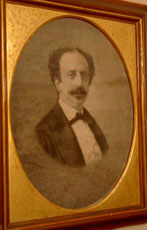
Angelo Morbelli (on
the left) and the
Portrait of his
father Giovanni Morbelli (on the right)
Further to a youthful auditory disease, Morbelli was forced
to leave his musical interests and in 1867 he entered the
Brera Academy thanks to a scholarship offered by the Alessandria’s
municipality (his father was on leave with a half salary
cut). He attended with profit and he succeeded in gaining
plenty of acknowledgments such as the silver medal for a
figure drawing. At the end of school, Morbelli started his
long displaying career: his work of art soon started being
known in Milan, then in the rest of Italy and finally in
the main European and American cities.
During these years he lived in Milan, with the exception
of few summer periods in which he spent his holidays in
the countryside house situated in the Colma of Rosignano:
a charming place in the Monferrato region, called “Villa
Maria” in praise of the beloved Morbelli’s wife,
who was always his irreplaceable locus animae. This residence
was the starting point and place of arrival of a complex
epistolary net, which tightly united many guests from Casale
and its surroundings, among the others: Leonardo Bistolfi
and Francesco Negri (who secured the memory by photographing
the original Morbelli’s atelier), Pellizza da Volpedo,
Giovanni Cena and the English artists: Samuel Butler and
his biographer Henry Festing Jones.
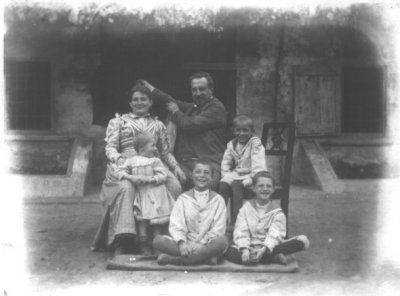
Angelo Morbelli with his wife and
sons
At the beginning of the ‘800s dated back the first
Morbelli’s series of successes. The painter became
popular with the anguished theme of the old age, depicted
in the famous paintings realised inside the Pio Albergo
Trivulzio in Milan. The following years Morbelli joined
the group of artists close to the painter Vittore Grubicy.
Grubicy worked out studies on the light and its colours,
essential premises for the upcoming choice of the Pointillism,
which characterises Morbelli’s unmistakeable pictorial
style.
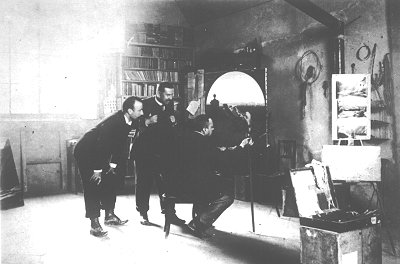
Angelo Morbelli and friends in its
atelier
A brief interlude, influenced by symbolism, between the
two centuries, did not take Morbelli’s mind off his
growing interest for the landscape painting, which became
his favourite subject in many paintings realised in the
Colma of Rosignano, many of them set in “Villa Maria”.
The wonderful atelier-house, where he loved to immortalize
the geranium vases with the background of the beloved Monferrato
hills, became the artist’s meeting place of the “new
pictorial art of Pointillism”, visually recalled by
the portraits of the artists such as: Segantini, Pellizza,
Longoni, Bistolfi and Quadrelli, immortalized by the paintbrush
of Giovanni Sottocornola.
Towards the end of his prolific life, Morbelli devoted
himself to the theoretic meditations on aesthetics, carefully
noted in his diary titled The Via Crucis of Pointillism.
Angelo Morbelli died in Milan on November 7th, 1919.
Morbelli's art
(by Giuliana Romano Bussola)
Angelo Morbelli has finally been dutifully and praiseworthy
recognised among the greatest painters of the pointillism;
scholars regretfully considered for too long Morbelli’s
art less important as hierarchically compared to the other
exponents of the movement; though each of the pointillist
artists had his own personal style. Morbelli’s realism
is no less important than: Previati’s dazzled decorativism,
Pellizza’s proletarian mysticism or Segantini’s
pantheism. As soon as fashion faded away, the social moods
which influenced the taste succeeded in undermining the
prejudice according which the technical skill works against
art and Morbelli clearly showed not only how the pointillism
rules-abiding was, which was his main creed, but also how
sensitive towards the humanity he was.
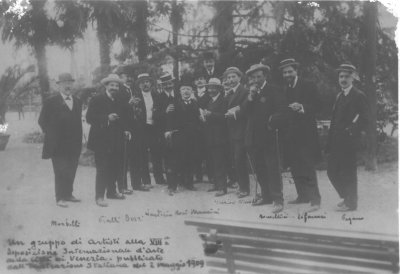
2nd may 1909 - Angelo Morbelli
(first on the left)
with other
artists at the VIII Art Exibition in Venice
Representative of the Verism and fatalistic in his way
of seeing life, sometimes even with a light touch of scepticism,
Morbelli describes the reality throughout the use of photography,
without judgements, without arguing or gratifying himself;
he dares not sweetening or dramatizing the reality yet Morbelli
succeeds in seizing the moods and psycho logic aspects of
the human nature. Some of these elements are clearly showed
in the paintings of the Pio Albergo Trivulzio and also the
landscape paintings where a tender twilight melancholy brings
to mind feelings of participation between man and nature.
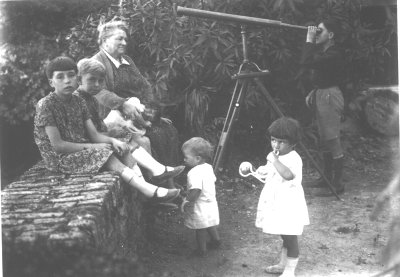
his wife Maria
with little friends (coll. Lativa 2)
To the climate of philanthropy to which Morbelli clearly
approaches, though in a warmer way as compared with his
affectionate friend Pellizza, more active and utopian, Morbelli
adds his deep love for nature. Linked to this subject, dealt
with a great care in his “vecchioni e vecchine”
(Old men and old women), we can seize the shift from Impressionism
to Neo-Impressionism. The main outlines concerning the pure
colour, the optic “melange”, the anti-academicism
have been preserved, but he substitutes the fleeting impression
given by the “plein air” with the reflection
and the subsequent accurate and strict drawing up in study.
Morbelli’s study is still intact within his summer
residence situated in the Colma of Rosignano, preserved
with accuracy by his heirs, where the artist spent his time
with his friends and his beloved to immerse himself in the
simple countryside atmosphere. In particular, the garden
has been maintained untouched, the same place where Morbelli
set his easel to sketch: La lezione sul prato (The lesson
on the grass), I vasi di geranio (Geranium vases),
Il capitello
(The capital), L’ingresso alla Colma (Entrance to
the Colma). In all these paintings come out not only Morbelli’s
stylistic greatness but also a man who made art his main
reason of life.
|